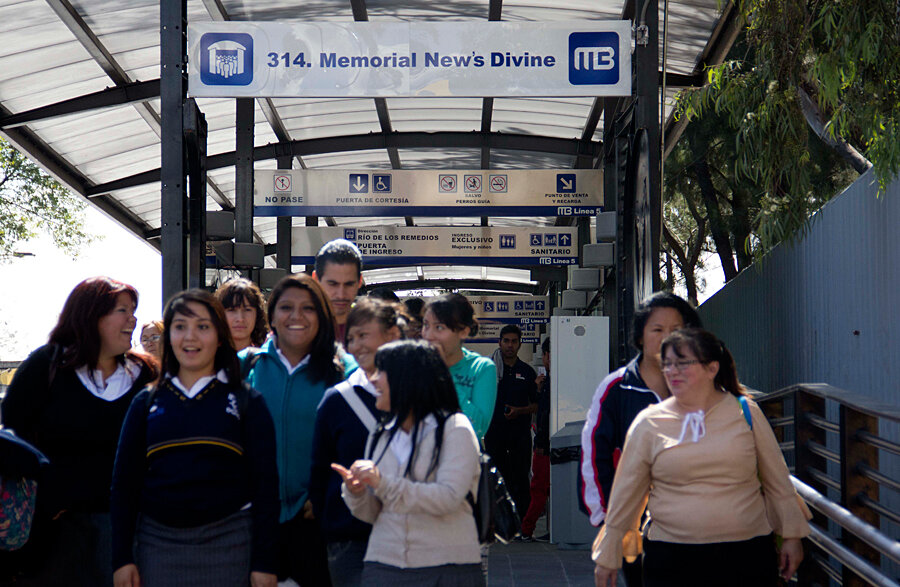Mexico City's metro: the politics of a price increase
| Mexico City
Book vendor Antonio Manriquez hauls some 50 titles in a small suitcase six days a week through the Mexico City metro. He used to pay 3 pesos (less than $0.25) for his 30-minute commute, but that ended last Friday, when the Mexico City government raised the one-way fare to 5 pesos.
The controversial price hike is an attempt to stem the metro system’s financial losses and improve services in a transportation option famed for crisscrossing one of the biggest cities in the world, but notorious for neglected infrastructure, pickpockets, and overcrowding.
“It was a drastic measure by the government,” Mr. Manriquez says outside a metro station near the Chapultepec Park, where his books – ranging from Nietzsche to Beatles song sheets – are spread out on the sidewalk.
“If our earnings aren’t going up, it’s kind of difficult raise metro prices,” he says, noting that none of his wares are selling especially well this year.
The Mexico City metro transports more than 5 million passengers daily and is considered a necessity by workers like Manriquez, who have to travel large distances every day.
But the long-subsidized system is unsustainable and service has slipped, according to the Federal District government, which wants to put the increased revenues into improvements for the Sistema de Transporte Colectivo, as the metro is formally known.
The state of the system is cause for concern for the administration of a city that has cleaned up its air over the last 20 years. Officials are encouraging commuters to leave cars at home by expanding dedicated lanes for the mass-transit bus service known as the Metrobus and promoting a popular bike-sharing service, which has signed up nearly 100,000 subscribers thus far.
It's also creating controversy as protesters organizing with the hashtag, #PosMeSalto ("Well, I’ll Jump") have swarmed metro stations and hopped turnstiles en masse to avoid paying fares. Party allies of Mayor Miguel Ángel Mancera have jeered him publicly over the increased fare.
Poverty, polls, and problems
The metro was born in 1969 as a highly subsidized transport system, says Aldo Muñoz Armenta, political science professor at the Autonomous University of Mexico State.
“This created a culture of appreciation and defending its low costs,” Mr. Muñoz says.
The metro system has 12 lines and 140 miles of track, and is a lifeline for many of Mexico City’s working-class ridership who toil in the informal economy with a daily minimum wage of $5, says David Lozano Tovar, economic studies professor at the National Autonomous University of Mexico.
The Federal District of Mexico City, dubbed “DF” by locals, is home to 9 million residents; another 11 million live in municipalities in outlying Mexico state, which surrounds DF like a horseshoe.
Coordination between the distrct government and surrounding Mexico State is lacking, leading to inefficiencies and higher costs for riders, says Gabriel Tarriba, who studies urban issues for the Mexican Competitiveness Institute, a Mexico City think tank.
“The underlying problem is that there’s not public transit planning for the [entire] metropolitan area,” Mr. Tarriba says.
A study commissioned by Mancera's administration and released in November found that 30 percent of all trains are broken down and out of service. The trains remaining in rotation have mechanical problems three times more often than in 2007. Poor ventilation, meanwhile, causes temperatures to top 85 degrees in some tunnels.
Slightly more than 50 percent of survey respondents at metro stations told pollsters they would pay more to ride the trains. (Mr. Lozano and Muñoz allege the polls were designed to induce such answers) The survey also found that 50 percent of respondents said the first train arriving at their station was too full to take on more riders.
The study also identified corruption in the system. This is mainly manifested through vendors at metro stations hawking anything from pens and pencils to CDs – peddled by people with big speakers strapped to their backs, blaring music in confined spaces. This despite rules against such practices and a police presence .
“People are bothered by the [fare] increase, but above all because they feel that they’ll pay, [but] things will stay the same,” Tarriba says.





